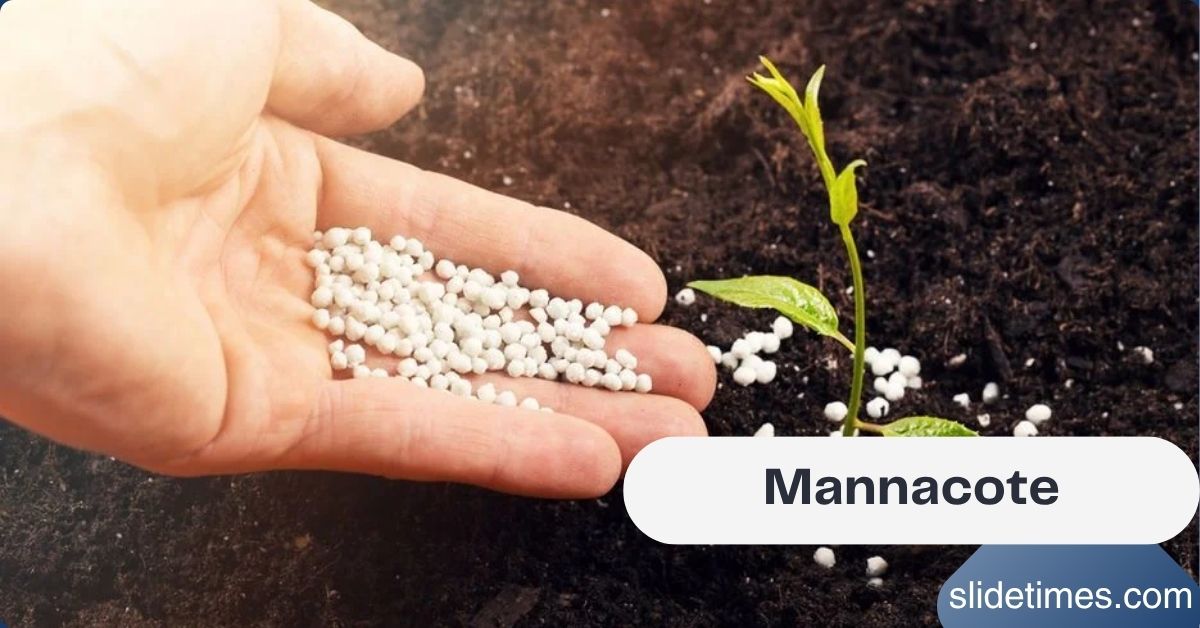Mannacote is fast becoming a well-known name in sustainable agriculture and plant nutrition. As the need for efficient, long-term crop care and growth intensifies, Mannacote provides an innovative solution that goes beyond conventional fertilizers. In this ultimate guide, we will explore everything you need to know about Mannacote—its benefits, how it works, its impact on sustainable agriculture, and why it is the key to promoting efficient and consistent crop growth.
What Is Mannacote?
Mannacote is a specialized slow-release fertilizer designed to provide plants with a steady supply of nutrients over an extended period. Unlike conventional fertilizers, which release nutrients rapidly and often lead to nutrient leaching, Mannacote is formulated to release nutrients gradually, making it highly efficient for long-term plant health and productivity.
Developed with a focus on sustainability, Mannacote is engineered to meet the demands of modern agriculture. Whether you’re a hobby gardener, a landscaper, or a professional farmer, Mannacote offers a reliable way to maintain nutrient-rich soil that promotes plant growth while minimizing the environmental impact.

How Does Mannacote Work?
Mannacote operates through a unique slow-release mechanism that helps plants receive nutrients continuously over a period of several months. The fertilizer is made with a specialized coating technology that controls the release rate of the nutrients. This ensures that the plants receive a consistent supply of essential elements, such as nitrogen, phosphorus, and potassium, without the risk of over-fertilization or nutrient loss.
Also Read: https://gadgetzona.net/2020/10/mejores-editores-de-fotos-para-iphone/
The slow-release nature of Mannacote also prevents nutrient runoff, which can be harmful to the environment. Traditional fertilizers, especially in liquid form, can wash away quickly with rainfall or irrigation, leading to environmental degradation and wasted resources. Mannacote, on the other hand, ensures that nutrients stay where they are needed, reducing environmental impact and maximizing crop yields.
Key Benefits of Using Mannacote
- Sustainable Plant Nutrition
Mannacote promotes long-term plant health by offering a continuous supply of nutrients. Its slow-release technology helps build healthier, more resilient plants that can withstand environmental stresses such as drought or disease. - Efficiency in Crop Growth
With Mannacote, plants receive nutrients at a steady pace, enhancing their growth potential. It eliminates the need for frequent reapplication, saving both time and money for farmers and gardeners alike. - Reduction of Environmental Impact
One of the most significant benefits of Mannacote is its ability to reduce the environmental footprint of plant nutrition. Unlike traditional fertilizers, which often leach away into water systems, Mannacote ensures that nutrients are effectively utilized by plants, preventing runoff and reducing pollution. - Improved Soil Health
Mannacote supports soil health by releasing nutrients gradually. This helps maintain a balanced nutrient profile in the soil, preventing nutrient imbalances and promoting sustainable farming practices. - Cost-Effective
While the initial cost of Mannacote may be higher than conventional fertilizers, its long-term efficiency leads to cost savings. Farmers can reduce the frequency of fertilizer application and improve overall crop yield, making it a worthwhile investment.
How to Use Mannacote for Maximum Results
Using Mannacote correctly ensures that your plants receive the full benefits of its slow-release formula. Here’s a step-by-step guide on how to use Mannacote effectively:
Also Read: Zoderzinxcrose: New Hope for Inflammation Sufferers
- Determine the Right Quantity
The amount of Mannacote you need depends on the type of crop, soil conditions, and the plant’s nutrient requirements. For optimal results, consult the packaging instructions or reach out to a local agricultural expert for guidance. - Apply Evenly
For best results, distribute Mannacote evenly across the soil surface. This ensures that the nutrients are accessible to the plants’ root systems, helping them absorb the nutrients efficiently. - Water Properly
After applying Mannacote, water the area thoroughly. This helps the fertilizer settle into the soil and kick-start the slow-release process. Be sure not to overwater, as excessive moisture can cause nutrient runoff in traditional fertilizers, though Mannacote’s slow-release mechanism minimizes this risk. - Monitor Plant Growth
Over time, observe the growth patterns of your plants. Mannacote is designed for long-term use, so expect gradual improvements in plant health and yield.
Mannacote and Sustainable Agriculture
Sustainability is at the heart of modern agriculture. As the global population continues to grow, it becomes increasingly important to adopt farming practices that can support higher yields without compromising environmental health. Mannacote plays a pivotal role in this shift.
- Reducing Soil Erosion
By reducing the need for frequent fertilizer applications, Mannacote helps minimize the disturbance to the soil. Less frequent tilling and less chemical runoff mean the soil remains intact and less prone to erosion. - Lower Carbon Footprint
Mannacote’s slow-release technology reduces the need for transportation and application of fertilizers, which in turn lowers the carbon footprint associated with traditional fertilization practices. - Supporting Regenerative Farming
Farmers focused on regenerative practices can use Mannacote to support soil regeneration. Its ability to release nutrients gradually and efficiently helps maintain the balance of organic matter in the soil, an essential component of regenerative farming.
Mannacote vs. Traditional Fertilizers: Which Is Better?
When it comes to fertilizing crops, the choice between Mannacote and traditional fertilizers can be pivotal in terms of both environmental impact and agricultural productivity.
Also Read: Zooskooñ: An Extraordinary Flower from the
Nutrient Release Rate
- Mannacote: Offers a slow and controlled release of nutrients, ensuring consistent plant nutrition over time.
- Traditional Fertilizers: Often provide a quick nutrient release, which can lead to nutrient imbalances and the potential for over-fertilization.
Environmental Impact
- Mannacote: Reduces nutrient runoff and leaching, minimizing the negative environmental impact.
- Traditional Fertilizers: Are more prone to causing nutrient runoff, which can contaminate water systems.
Cost and Efficiency
- Mannacote: While the initial investment is higher, its slow-release formula leads to fewer applications and greater efficiency, ultimately saving money.
- Traditional Fertilizers: While initially cheaper, they require frequent applications, leading to higher long-term costs.
Mannacote in Different Agricultural Systems
Mannacote is versatile and can be used in various agricultural settings, from large-scale farms to home gardens. Below are some of the key applications of Mannacote in different farming systems:
- Organic Farming
Organic farmers can incorporate Mannacote into their nutrient management strategies. Its slow-release properties align with organic farming principles, reducing the need for chemical inputs. - Hydroponics and Greenhouses
For hydroponic and greenhouse operations, Mannacote can be an excellent way to ensure a steady supply of nutrients without the need for constant monitoring and reapplication. - Landscaping
For landscaping and ornamental plants, Mannacote’s ability to promote consistent growth and vibrant health makes it an excellent choice for professional landscapers.
Also Read: Sylveer: Understanding the Creativity and Introspection Behind the Name
FAQs About Mannacote
How often should Mannacote be applied?
Mannacote’s slow-release formula means that it only needs to be applied a few times a year, depending on the crop. Typically, it lasts between 3 to 6 months before requiring reapplication.
Is Mannacote safe for the environment?
Yes, Mannacote is designed to minimize environmental impact. Its slow-release nature helps reduce nutrient runoff, which can be harmful to water systems.
Can Mannacote be used on all types of plants?
Yes, Mannacote can be used on a wide range of plants, from vegetables and fruits to ornamental plants and trees. Always follow the recommended application rates for the specific crop.
How does Mannacote compare to other slow-release fertilizers?
Mannacote stands out due to its advanced coating technology that ensures nutrients are released gradually over an extended period. This makes it more efficient and environmentally friendly than many traditional slow-release fertilizers.
Can I use Mannacote in combination with other fertilizers?
Yes, Mannacote can be used alongside other fertilizers, but it is essential to ensure that the combined fertilizers do not exceed the recommended nutrient levels for the plants.
Conclusion
Mannacote offers an innovative and sustainable solution for long-term plant nutrition. By ensuring a consistent, efficient release of nutrients, it promotes healthier crops, reduces environmental impact, and increases cost-effectiveness in farming practices. Whether you’re a professional farmer or a home gardener, adopting Mannacote can help ensure that your plants thrive while contributing to a more sustainable agricultural future.
